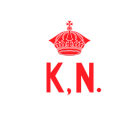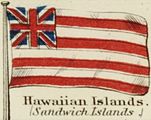Flag of Hawaii
 | |
| Ka Hae Hawaiʻi | |
| Use | Civil and state flag |
|---|---|
| Proportion | 1:2 |
| Adopted | December 29, 1845 |
| Design | Eight alternating horizontal stripes of white, red, and blue, with the United Kingdom's Union Flag (ratio 4:7) in the canton |
| Designed by | Alexander Adams |
The flag of Hawaii was first adopted in the early 19th century by the Hawaiian Kingdom and continued to be used after its overthrow in 1893. It is the only U.S. state flag to feature a foreign country's national flag—that of the Union Jack—which commemorates the British Royal Navy's historical relations with the Kingdom of Hawaii, and in particular the pro-British sentiment of its first ruler, King Kamehameha I.[1][2]
The Hawaiian flag is among the most iconic and recognizable in the U.S., being noted by vexillologists for its design and aesthetics.[3] Its eight stripes represent the main islands of the Hawaiian archipelago. The colors of the stripes do not have any official symbolism.[4]
History
[edit]Before 1816
[edit]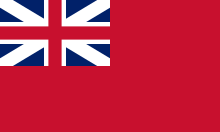

Captain George Vancouver of the British Royal Navy visited the Hawaiian Islands on three occasions during his 1791 to 1795 expedition. In February 1794, while at anchorage in Kealakekua Bay off the island of Hawaii, Vancouver reached a diplomatic agreement with the king of that island, Kamehameha, who would later become the first ruler of the Kingdom of Hawaii. Vancouver believed that Hawaii Island was being ceded to Great Britain but historians have argued that the Hawaiians saw the agreement as establishing a protectorate.[5] After the proceedings on Vancouver's vessel, a British flag was presented, taken ashore and raised. The flag was either a British Union Jack,[6][7] or a Red Ensign as used by the Royal Navy, which features a Union Jack in the canton.[8][9][a] In 1801, the Union Jack added a Saint Patrick's Cross when Ireland joined with Great Britain in a political union. Both pre- and post-1801 versions of the Red Ensign served as the unofficial flag of the Kingdom of Hawaii until 1816.[7]
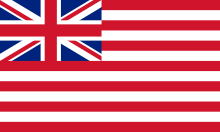

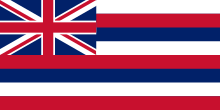
Current flag (1816–present)
[edit]Scottish Captain Alexander Adams' journals mention the British East India Company flag when Kamehameha had originally purchased Adams' brig named the Forester and renamed Kaahumanu. As part of the ship's transfer, the ensign of the East India Company, which consisted of the Union Jack on a field of red-and-white stripes, was taken by Adams during a ceremony with an 11-gun salute. Many older Native Hawaiians prior to 1921 believed that the current flag of Hawaii was created by Adams during his trip to China in 1817. At that time Adams was Commander of the Hawaiian Kingdom Navy,[11] captaining the Kaahumanu under King Kamehameha I.[12] While there is no indication that the flag was either made or flown during that period, Adams did note that on his way to China, while stopping at Waimea, Kauai for supplies, he did give Kaumualiʻi his own ensign to raise at the port, as the king only had a Russian flag left from the Russian colony in Hawaii.[13][14]
March 12, 1817. Gave the King (Kaumualii) our ensign to hoist in lieu of the Russian, who said that it was on account of his having no other.[15]
There may have been different versions of the flag with different numbers of stripes and colors.[16] The number of stripes also changed: originally, the flag was designed with either seven or nine horizontal stripes, and in 1845 it was officially changed to eight stripes. The latter arrangement is used today.[17]

Kānaka Maoli flag
[edit]
The Kānaka Maoli ('true people' in the Hawaiian language) design is purported by some to be the original flag of the Kingdom of Hawaiʻi, though this claim is unverified and widely disputed.[18][19] It was introduced to the public by Gene Simeona in 2001.[20] It has nine alternating stripes of green, red, and yellow defaced with a green shield with a puela (strip of kapa bark cloth insignia flown atop the double hulled canoe of the chief) crossed by two paddles.
Gene Simeona claims to have unearthed the Kānaka Maoli flag in 1999. Simeona said he encountered a descendant of Lord George Paulet who told him about an earlier flag. Simeona claims to have found evidence of the Kanaka Maoli flag in the state archives, though any sources he may have used have not been identified.[21] Subsequent efforts to verify Simeona's claim have been unsuccessful.[21] Critics of the claim have pointed to evidence of the widely accepted Hawaiian flag being in existence before the Kanaka Maoli flag.[22][21][original research?]

Louis "Buzzy" Agard had proposed a Hawaiian flag design in 1993 which featured nine alternating stripes and the same charge as on the Kanaka Maoli flag,[23] leading many to believe it is where Simeona drew his inspiration.[22]
Despite the lack of verification about its historic use, the design is popular among those who prefer its lack of apparent colonial imagery.[18]
Design
[edit]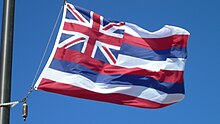
The canton of the flag of Hawaii contains the Union Flag of the United Kingdom, prominent over the top quarter closest to the flag mast. The field of the flag is composed of eight horizontal stripes, symbolizing the eight major islands (Hawaiʻi, Maui, Kahoʻolawe, Lānaʻi, Molokaʻi, Oʻahu, Kauaʻi, and Niʻihau). Other versions of the flag have only seven stripes, probably representing the islands with the exception of Kahoʻolawe or Niʻihau. The color of the stripes, from the top down, follows the sequence: white, red, blue, white, red, blue, white, red. The colors were standardized in 1843, although other combinations have been seen and are occasionally still used.[24][25]
In 2001, a survey conducted by the North American Vexillological Association (NAVA) placed Hawaii's flag 11th in design quality, out of the 72 U.S. and Canadian provincial, state, and territorial flags ranked.[26]
Despite superficially resembling the flags of British Overseas Territories, the Hawaiian flag is proportioned differently – the Union Jack in the canton is in a 4:7 ratio,[27] and a differing standard is used to define the colors.[citation needed]
Lā Hae Hawaiʻi
[edit]In 1990, Governor of Hawaii John Waihee proclaimed July 31 to be Lā Hae Hawaiʻi, the Hawaiian Flag Day. It has been celebrated each year since then.[28] It is the same date as Lā Hoʻihoʻi Ea, Sovereignty Restoration Day, a holiday of the Kingdom of Hawaiʻi that is celebrated by proponents of the Hawaiian sovereignty movement.
Flag of the Governor
[edit]The flag used by the governor of Hawaii is a red and blue bi-color. In the middle of the eight white stars appears the name of the state in all capital letters. During the time Hawaii was a United States territory, the letters in the middle of the flag were "TH", which stood for "Territory of Hawaii".[29]
Chronology
[edit]Date Flag Image 1793–1800 British Red Ensign[30] 
1801–1816 British Red Ensign following the Acts of Union with Ireland 
1816–1845 Early version of the present flag (1:2 canton) 
February 1843 – July 1843 Union Flag (during the Paulet Affair) 
1845–1898 The current Hawaiian flag introduced in 1845 (4:7 canton) 
February 1893 – April 1893 US flag (after the overthrow of the Kingdom of Hawaii) 
1898–present Hawaiian flag used by the US territory and state of Hawaii 
Gallery
[edit]-
Personal Standard of King Kalakaua
-
Personal Standard of Princess Kaiulani
-
Naval Ensign of the Kingdom of Hawaii, with the only known use of this flag being on the Kaimiloa
-
Naval Jack of the Kingdom of Hawaii, flown on the bowsprit of the Kaimiloa
-
Flag of the Kuhina Nui in the Hawaiian Kingdom
-
The inverted Hawaiian flag represents the Hawaiian Kingdom in distress and has served as the main symbol of the Hawaiian sovereignty movement
-
Flag of Hawaiian people used in Unrepresented Nations and Peoples Organization
-
Flag of Nation of Hawaiʻi
-
1868 flag chart
-
Hawaiian quilt from Waimea, before 1918
See also
[edit]- List of flags by design
- List of Hawaii state symbols
- List of U.S. state, district, and territorial insignia
References
[edit]- ^ Marshall, Tim (2017). A Flag Worth Dying For: The Power and Politics of National Symbols. Simon and Schuster. pp. 52–53. ISBN 9781501168338.
- ^ Bloss, Janet Adele (1983). State Flags. Willowisp Press. p. 66. ISBN 9780874061833.
- ^ Edward B. Kaye (10 June 2001). "2001 State/Provincial Flag Survey" (PDF). nava.org. North American Vexillological Association
- ^ "Flag of Hawaii | United States state flag". Britannica. Retrieved May 26, 2023.
- ^ Bown, Stephen R. (2008). Madness, betrayal and the lash: the epic voyage of Captain George Vancouver. Vancouver: Douglas and McIntyre. pp. 190–191. ISBN 978-1-55365-339-4.
- ^ "Flag of Hawaii | Meaning, History & Facts | Britannica". www.britannica.com. October 1, 2024. Retrieved November 26, 2024.
- ^ a b Healy, Donald T.; Orenski, Peter J. (January 12, 2016). Native American Flags. University of Oklahoma Press. p. 279. ISBN 978-0-8061-5575-3 – via Google Books.
- ^ Fisher, Lynn. "Hawaii". US Flags [dot] Design. Retrieved November 26, 2024.
- ^ "The Story Of Hawaii - Story Of Hawaii Museum: 'THE HAWAIIAN FLAG'". storyofhawaiimuseum.com. August 9, 2018. Retrieved November 30, 2024.
- ^ Vancouver, George (1798). A Voyage of Discovery to the North Pacific Ocean and Round the World, Volume 3. London. pp. 56}.
- ^ Fry, Michael (2001). The Scottish Empire. Tuckwell. p. 235. ISBN 978-1-86232-185-4 – via Google Books.
- ^ Native Hawaiians Study Commission: Hearings Before the Committee on Energy and Natural Resources, United States Senate, Ninety-eighth Congress, Second Session, on the Report of the Native Hawaiians Study Commission. Committee on Energy and Natural Resources, US Senate; US Government Printing Office. 1985. p. 427.
- ^ The Friend. February 1921. pp. 36, 43 – via Google Books.
- ^ Pierce, Richard A. (1965). Russia's Hawaiian Adventure, 1815–1817. University of California Press. p. 13. GGKEY:D93WWZ14DB5 – via Google Books.
- ^ Annual Report of the Hawaiian Historical Society. Hawaiian Historical Society. 1898. p. 8 – via Google Books.
- ^ Ballou, Howard M. (1906). The Reversal of the Hawaiian Flag. pp. 5–11. ISBN 0-8028-5088-X.
- ^ Quaife, Milo; Weig, M. J.; Appleman, R. E. (1961). The History of the United States Flag. New York: Harper. p. 154.
- ^ a b "What's the Story Behind Hawaii's Flag?". Hawaii Magazine. October 21, 2008. Retrieved September 21, 2022.
- ^ Pulse, Big Island (August 20, 2019). "Kanaka Maoli Flag – Hawaii's Original Flag or Clever Marketing?". Big Island Pulse. Retrieved September 21, 2022.
- ^ "What's the Story Behind Hawaii's Flag?". Hawaii Magazine. October 21, 2008. Retrieved June 15, 2023.
- ^ a b c Anwar, Yasmin (February 12, 2001). "'Original' flag raises debate". Honolulu Advertiser. Archived from the original on June 4, 2007. Retrieved September 22, 2022.
- ^ a b Kingdom, Hawaiian (December 13, 2014). "Origin of the Hawaiian Kingdom Flag". Hawaiian Kingdom Blog. Retrieved September 22, 2022.
- ^ Agard, Louis "Buzz" (1993). He Alo a He Alo – Hawaiian Voices on Sovereignty. Honolulu: American Friends Service Committee. pp. 108–110. ISBN 9780910082259.
- ^ "Name and Insignia of Hawaii – State Flag". Hawaii State Library. March 1, 2006. Archived from the original on May 11, 2007. Retrieved October 25, 2007.
- ^ BBC History, Jan 2008
- ^ "2001 State/Provincial Flag Survey" (PDF). nava.org.
- ^ "[§5–19] Description of the Hawaiian flag". Hawaii State Legislature. Retrieved March 11, 2022.
- ^ "Ka Hae Hawai'i – The Hawaiian Flag". Hawaii Public Radio. Retrieved July 29, 2020.
- ^ "Name and Insignia of Hawaii – Governor's Flag". Hawaii State Library. March 1, 2006. Archived from the original on May 11, 2007. Retrieved October 25, 2007.
- ^ All about Hawaii: The Recognized Book of Authentic Information on Hawaii, Combined with Thrum's Hawaiian Annual and Standard Guide. Honolulu Star-Bulletin. 1974.
















